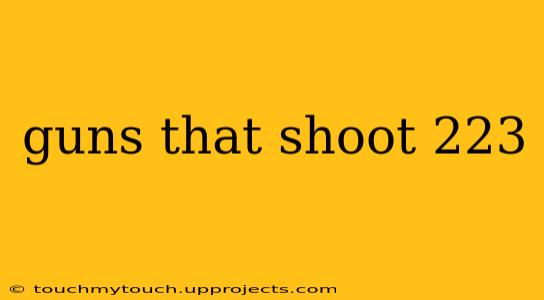The .223 Remington, and its military counterpart the 5.56x45mm NATO, are incredibly popular calibers for a variety of reasons. Their relatively small size and recoil make them manageable for many shooters, while their accuracy and effectiveness at moderate ranges make them suitable for everything from target shooting to hunting small game to home defense. This guide explores the diverse range of firearms chambered in .223, helping you understand the options available and find the best fit for your needs.
Types of .223 Guns
The .223 caliber is used in a wide variety of firearms, each with its own strengths and weaknesses. Here are some of the most common types:
1. AR-15 Style Rifles:
- Popularity: These are arguably the most popular platform for .223, renowned for their modularity and adaptability. You can customize almost every aspect, from the stock and grip to the barrel length and optics.
- Strengths: Versatile, accurate, relatively lightweight, and widely available aftermarket parts.
- Weaknesses: Can be expensive to build or buy fully kitted out, and the modularity can be overwhelming for beginners.
- Examples: Many manufacturers produce AR-15s, including Colt, Smith & Wesson, Ruger, and many others.
2. Bolt-Action Rifles:
- Popularity: While less common than AR-15s for .223, bolt-action rifles offer excellent accuracy and are often preferred for long-range shooting and hunting.
- Strengths: Precise, reliable, generally more affordable than high-end AR-15s, and excellent for hunting applications.
- Weaknesses: Slower rate of fire compared to semi-automatic options.
- Examples: Several manufacturers offer bolt-action rifles in .223, including Ruger, Savage, and Remington.
3. Semi-Automatic Carbines:
- Popularity: Beyond the AR-15 platform, several other semi-automatic carbines are chambered in .223. These often offer a balance between the maneuverability of a carbine and the power of a larger caliber rifle.
- Strengths: Good balance of accuracy, manageable recoil, and rapid firing capabilities.
- Weaknesses: May not be as customizable as AR-15s.
- Examples: Consider models from manufacturers like Ruger, Kel-Tec, and others.
4. Handguns:
- Popularity: While less common, .223 handguns are emerging, pushing the boundaries of what is possible in pistol calibers.
- Strengths: High stopping power, albeit with significant recoil.
- Weaknesses: Recoil can be intense, limiting their usability and practicality for many shooters.
- Examples: While less prevalent, you will find several brands experimenting with .223 handguns.
Choosing the Right .223 Gun
The best .223 gun for you will depend on your individual needs and preferences. Consider the following factors:
1. Intended Use:
- Target Shooting: Accuracy is paramount; consider a bolt-action or a high-quality AR-15 with a good barrel.
- Hunting: Bolt-action rifles are often preferred for their accuracy and reliability, especially at longer ranges.
- Home Defense: A semi-automatic carbine like an AR-15 is frequently chosen for its rapid firing capability, but consider the legal implications and the potential for overpenetration.
- Competition: The specific needs of the competition will dictate the choice of firearm, with AR-15 platforms common in many disciplines.
2. Budget:
Prices vary widely depending on the manufacturer, features, and level of customization. Set a realistic budget before starting your search.
3. Experience Level:
Beginners may find AR-15 platforms intimidating due to their complexity. Simpler options like bolt-action rifles or certain semi-automatic carbines might be a better starting point.
4. Ergonomics and Comfort:
The gun should feel comfortable and well-balanced in your hands. Try out different models if possible before making a purchase.
This guide provides a starting point for researching guns that shoot .223. Remember to always handle firearms responsibly and follow all applicable laws and regulations. Consulting with experienced shooters and gun professionals can be invaluable in making an informed decision. This information is for educational purposes only and does not constitute firearm advice. Always consult with a qualified professional before purchasing or handling any firearm.
